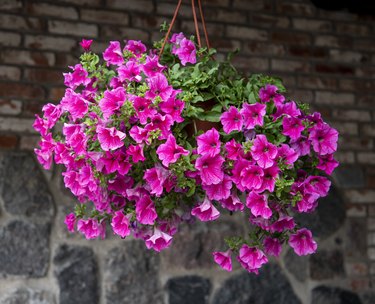
If most of your yard is shady, forget growing petunias (Petunia x hybrida, USDA zones 10-11). These popular ornamental plants that are usually grown as annuals perform best in full sunlight for most or all of the day. The proper amount of light is critical for petunias to produce lush, healthy foliage and ample flowers. Lack of sunlight leads to weak plants that are more prone to disease. Without sunlight, petunias also flower poorly with few blossoms through the otherwise productive summer months.
Tip
Petunias grow best in full sunshine with at least six to eight hours of direct sunlight every day. Without a full sun location, petunia plants can't produce as many flowers and may become spindly.
Video of the Day
Petunia Seedlings Sunlight Requirements
Petunia seeds require sunlight to germinate. Sow the seeds on the soil surface and place them in an area that receives bright light to ensure they sprout. Both seed-grown and purchased seedlings must be supplied with plenty of light until you're ready to transplant them outside.
Video of the Day
Set the petunias in a sunny window where they receive at least six hours of direct light a day. If you don't have a suitable window, use fluorescent or LED grow lights to provide enough light for the petunias to produce healthy, compact growth.
Full Sun Beds
Plant petunias in flower gardens that receive full sunlight whenever possible. Petunias flower best and produce the most compact growth when supplied with six to eight hours daily of sunlight. Before transplanting petunias to a full-sun bed, harden them off so they don't suffer leaf scalding from the bright light. Place potted petunias in an outdoor area protected from direct sunlight. Gradually move them into direct sun over the course of seven days before finally planting them in the garden bed.
Partial Sun Beds
While not preferred, petunias can grow in partial-sun beds. When this is necessary, choose a bed that receives full morning sun and dappled sunlight or bright shade in the later afternoon. Petunias may not flower as well when planted in partial sunlight, and the plants may become leggy and weak looking. Prune the petunia plants by up to half their height at midseason if they're weak and spindly. Pinching helps encourage a new flush of growth and makes the plants appear fuller.
Petunia Container Concerns
Container-planted petunias also do best in full sunlight, whether you're using a planter or hanging basket. The high amount of light causes the soil to heat up and dry out more quickly in the container. During the heat of summer, you may need to water your petunias daily to help prevent the soil from drying out too much. When possible, set the containers in an area where the petunias receive full sun but the base of the container receives shade. For example, A half barrel of petunias sitting behind a low shrub is shaded at the container level but sunlight can reach the petunias planted in the top unhindered.
Shady Flower Alternatives
While petunias don't grow well in shade, you can find many beautiful blooms that can handle part or full shade. Growing impatiens (Impatiens walleriana, USDA zones 10-11) is a good alternative when you have a shady spot that needs a little color. They can grow in part sun to shade. Impatiens have a similar look to petunias and come in a wide range of colors just like petunias, making them a suitable stand-in.